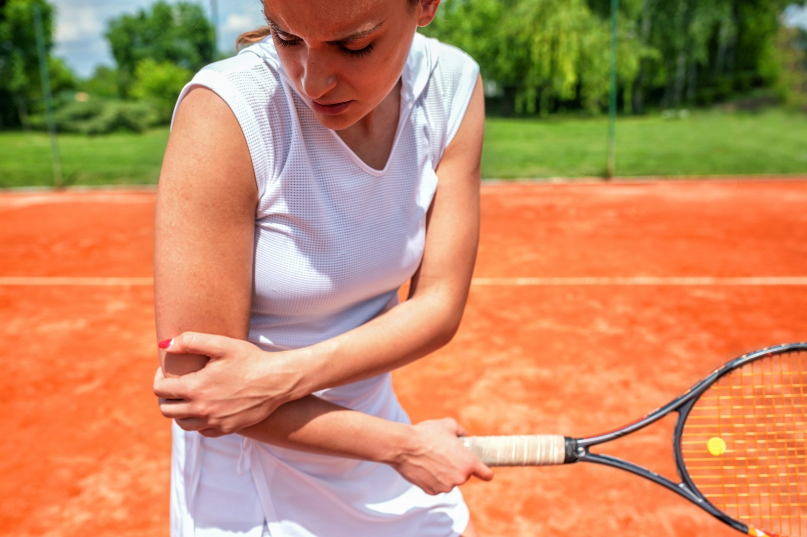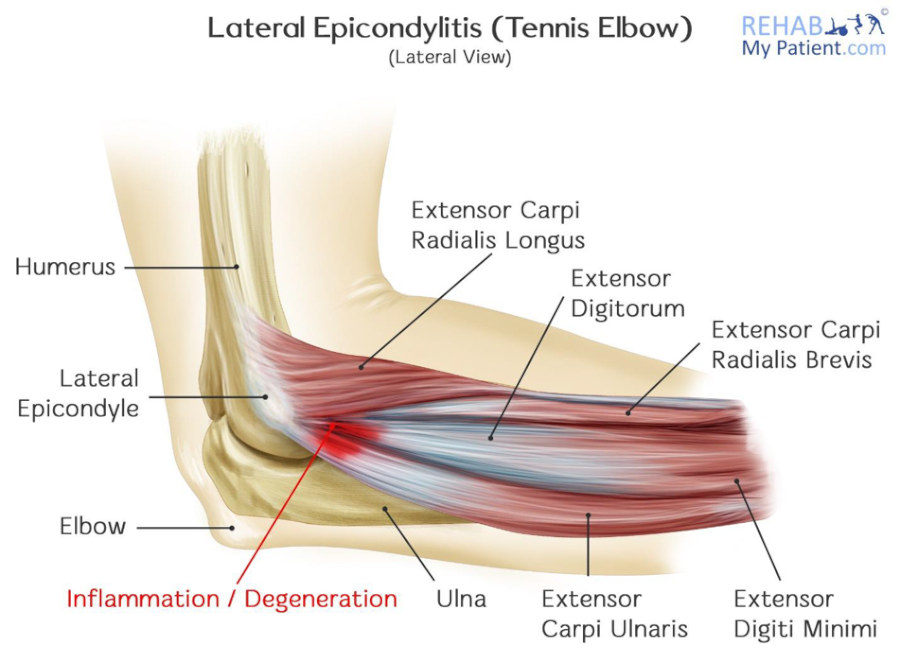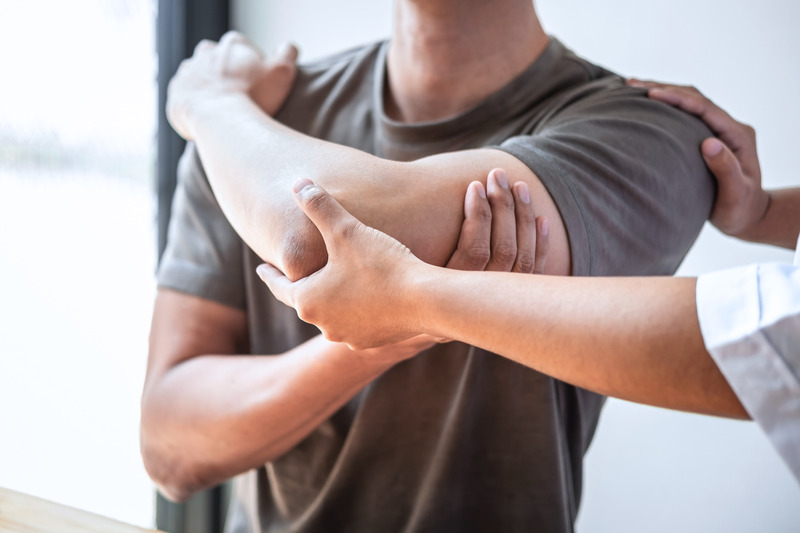What is Tennis Elbow?
Tennis elbow, also known as lateral epicondylitis, is a painful condition that occurs when the tendons on the outer part of the elbow become inflamed or damaged. Despite its name, tennis elbow is not limited to tennis players and can affect anyone who engages in repetitive arm movements that strain the wrist and forearm muscles.
The condition typically develops due to overuse of the forearm muscles and tendons, causing small tears or inflammation at the point where the tendons attach to the bony prominence (lateral epicondyle) on the outer part of the elbow. This can result in pain, tenderness, and reduced strength in the affected arm.

Anatomy of Tennis Elbow
- Lateral Epicondyle: This is a bony prominence on the outer part of the humerus bone (upper arm bone) near the elbow joint. It serves as the attachment point for several muscles and tendons involved in wrist and forearm movement.
- Extensor Muscles and Tendons: The extensor muscles of the forearm, such as the extensor carpi radialis brevis (ECRB), are responsible for extending the wrist and fingers. These muscles attach to the lateral epicondyle via tendons.
- Common Extensor Tendon: The tendons of the extensor muscles converge near the lateral epicondyle to form the common extensor tendon. This tendon attaches the extensor muscles to the lateral epicondyle and plays a crucial role in actions like gripping and lifting.
Physiology of Tennis Elbow
Tennis elbow occurs due to repetitive stress and overuse of the forearm extensor tendons, particularly the common extensor tendon. The repeated stress causes microscopic tears in the tendon tissue and triggers an inflammatory response. This leads to pain, tenderness, and sometimes swelling in the outer part of the elbow.
The precise mechanism behind the development of tennis elbow involves the following steps:
- Repetitive Strain: Engaging in activities that involve repetitive wrist and forearm movements, such as gripping a tennis racket, using a computer mouse, or lifting heavy objects, can place excessive strain on the extensor tendons that attach to the lateral epicondyle.
- Microscopic Tears: Over time, the repetitive strain and stress can lead to the development of small tears in the extensor tendons. These tears may not be immediately noticeable but contribute to the underlying damage.
- Inflammatory Response: As the body attempts to heal the microtears, an inflammatory response is triggered. This inflammation can lead to pain, swelling, and tenderness around the lateral epicondyle.
- Reduced Function: The inflammation and damage to the tendons can result in reduced strength and mobility in the affected forearm and wrist. Activities that involve gripping, lifting, or extending the wrist can become painful and challenging.
In summary, tennis elbow involves inflammation and damage of the tendons that attach to the lateral epicondyle, primarily due to repetitive strain and overuse of the forearm extensor muscles. This condition can be quite painful and can impact daily activities that involve the use of the affected arm.

The Etiology of Tennis Elbow
The etiology of tennis elbow, or lateral epicondylitis, involves a combination of factors related to repetitive strain, overuse, and biomechanical stress on the tendons and muscles of the forearm. While the exact cause may vary from person to person, the following factors contribute to the development of tennis elbow:
- Repetitive Movements: Engaging in activities that require repetitive wrist and forearm movements, such as gripping, lifting, and twisting, can place continuous stress on the tendons that attach to the lateral epicondyle. These activities can lead to microtears in the tendons over time.
- Incorrect Technique: Poor technique or improper form during activities such as playing sports (like tennis or golf), using tools, or performing manual labor can increase the strain on the forearm tendons, making them more susceptible to injury.
- Overuse and Fatigue: Performing the same motions repeatedly without adequate rest and recovery can lead to tendon fatigue and breakdown. Over time, this can contribute to the development of tennis elbow.
- Age and Degeneration: As people age, tendons naturally become less flexible and more prone to degeneration. This makes older individuals more susceptible to developing conditions like tennis elbow.
- Biomechanical Factors: Individual variations in forearm anatomy, such as alignment of bones, muscle imbalances, and joint stability, can influence how forces are distributed across the tendons. Poor biomechanics can lead to uneven stress on the tendons, increasing the risk of injury.
- Muscle Weakness and Imbalance: Weakness or imbalances in the forearm muscles can lead to increased stress on certain tendons, making them more susceptible to injury during repetitive activities.
- Sudden Intense Activity: Engaging in sudden and intense activities that the body is not accustomed to, especially those involving forceful gripping or wrist extension, can contribute to the development of tennis elbow.
- Occupational Factors: Certain occupations that involve repetitive hand and wrist movements, such as typing, carpentry, and painting, can increase the risk of developing tennis elbow.
- Inadequate Warm-Up: Failing to properly warm up and stretch the forearm muscles before engaging in activities that stress the tendons can make them more vulnerable to injury.
- Medical Conditions: Underlying medical conditions like rheumatoid arthritis or metabolic diseases can weaken tendons and increase the risk of developing conditions like tennis elbow.
It’s important to note that while the name “tennis elbow” implies a connection to tennis, this condition can affect people from various walks of life who engage in repetitive wrist and forearm movements. Proper technique, ergonomic adjustments, gradual progression in activity intensity, and adequate rest and recovery are some of the strategies that can help prevent the development of tennis elbow. If symptoms arise, early intervention, rest, and appropriate treatment are recommended to avoid further aggravation of the condition.
Chronic vs Acute Tennis Elbow
Acute Tennis Elbow
- Acute tennis elbow refers to the early stage of the condition when symptoms are relatively new and have recently developed.
- Typically, acute tennis elbow is characterized by pain, tenderness, and discomfort on the outer part of the elbow.
- The pain may be triggered or worsened by activities involving gripping, lifting, or extending the wrist.
- Swelling and inflammation may be present around the lateral epicondyle (the bony prominence on the outer part of the elbow).
- Acute tennis elbow can result from sudden or intense overuse of the forearm muscles and tendons, such as engaging in activities with poor technique or performing unfamiliar tasks.
Chronic Tennis Elbow
- Chronic tennis elbow refers to a more long-standing and persistent condition where the symptoms have been present for an extended period of time, typically beyond six months.
- In chronic cases, the pain and tenderness around the lateral epicondyle can persist and may become more intense or constant.
- The pain might continue to be aggravated by activities involving gripping, lifting, or wrist extension.
- Over time, if left untreated, the inflammation and tissue damage can lead to changes in the tendon structure and surrounding tissues.
- Chronic tennis elbow can result from ongoing repetitive strain, insufficient rest or recovery, or inadequate treatment of the acute phase.
It’s important to note that not all cases of acute tennis elbow progress to the chronic stage, and early intervention and appropriate management can often prevent the condition from becoming chronic. If you suspect you have tennis elbow or are experiencing symptoms, it’s advisable to seek medical attention. A healthcare professional can provide an accurate diagnosis, recommend appropriate treatment options, and guide you in managing the condition effectively to prevent it from becoming chronic or causing further complications.
How to Prevent Tennis Elbow
Preventing tennis elbow involves a combination of proper technique, equipment, strength training, and lifestyle adjustments. Here are some steps you can take to help prevent tennis elbow:
Proper Technique: Learn and use proper techniques for your sport or activity, whether it’s tennis, golf, or any other repetitive arm movement. Incorrect techniques can put excessive strain on the forearm muscles and tendons.
Warm-Up and Stretching: Always warm up your muscles before engaging in any physical activity. Perform gentle stretching exercises to improve flexibility in your forearm muscles.
Use Proper Equipment: Use sports equipment that is appropriately sized and fitted for your body. Ill-fitted equipment can contribute to improper form and increased strain on your muscles.
Gradual Progression: Avoid sudden increases in the intensity, duration, or frequency of your activities. Gradually progress to higher levels to allow your muscles and tendons to adapt.
Strength Training: Strengthen the muscles of your forearm, wrist, and grip through targeted exercises. Consult a fitness professional or physical therapist for guidance on effective exercises.
Balanced Workload: Distribute the workload evenly between both arms to avoid overloading one side. This is especially important during activities that involve repetitive arm movements.
Proper Rest and Recovery: Allow adequate time for rest and recovery between sessions. Give your muscles and tendons time to heal and adapt to the demands of your activity.
Ergonomic Considerations: Pay attention to your work environment. If your job involves repetitive arm movements, ensure that your workspace is ergonomically designed to reduce strain on your muscles.
Bracing or Taping: Consider using an elbow brace or taping techniques that provide support to the affected area during activities. Consult a healthcare professional for recommendations.
Listen to Your Body: If you experience any pain, discomfort, or early signs of tennis elbow, take a break from the activity causing the issue. Ignoring pain can worsen the condition.
Consult a Professional: If you’re unsure about your technique, equipment, or how to prevent tennis elbow, consult a sports coach, physical therapist, or healthcare professional. They can provide personalized guidance based on your needs.
Remember that prevention strategies may vary based on individual factors, such as your specific sport, fitness level, and overall health. If you’re already experiencing symptoms of tennis elbow, it’s important to seek medical advice for proper diagnosis and treatment.

There are some common exercises on how to prevent tennis elbow from happening (always consult a healthcare practitioner before partaking in exercise).
If you have been suffering from tennis elbow or elbow pain and aren’t sure what to do, book an intake call and get started on recovering!





